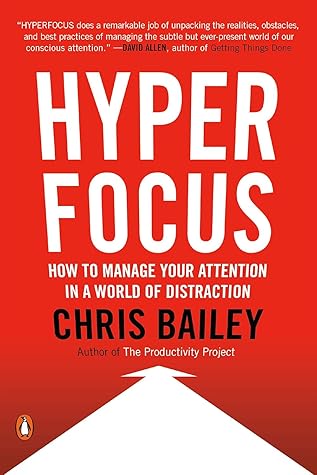More on this book
Community
Kindle Notes & Highlights
by
Chris Bailey
Read between
July 28 - August 1, 2020
Double down on developing the skills and knowledge that you find entertaining. Also opt for the medium you prefer—if you learn best by listening,
Add something valuable for each worthless thing you eliminate. Push yourself: the most valuable information you can consume is material that challenges you and usually requires your full attention.
4. Notice what you consume on autopilot mode.
If you’re going to veg out, do so with intention—set the criteria for what you plan to do, such as the number of episodes you’ll get through, what you’ll eat as you watch, what you’ll do afterward, and so on. This not only allows you to act with intention but also leaves you feeling less guilty so that you actually enjoy yourself.
7. Get things to bid for your attention. View the descriptions of podcasts, TV shows, movies, and books as a pitch for your time and attention.
8. In the moment, zoom out. Try zooming out to a larger time frame if you’re having trouble deciding in the moment between a few different things to consume.
10. Double down on what’s valuable. There are some topics you know more about, and some things you’re better at, than almost anyone in the world. The more dots you collect around these particular topics or skills, the more of an expert you’ll become. For each worthless thing you eliminate, consider doubling down on something you’re already good at or a subject you know a lot about.
I love this quote from British science fiction writer Arthur C. Clarke: “Any sufficiently advanced technology is indistinguishable from magic.” I’d take this a step further to argue that any sufficiently complex decision or idea is also indistinguishable from magic. Whenever we don’t understand the complex network of dots that contribute to some result, we ascribe it to magic or genius.
As author Malcolm Gladwell wrote: “Practice isn’t the thing you do once you’re good. It’s the thing you do that makes you good.”
Another of my favorite quotes is from Abraham Lincoln, who said, “Give me six hours to chop down a tree and I will spend the first four sharpening the axe.”
The brain needs a few minutes to switch between hyperfocus and scatterfocus. Therefore, taking scatterfocus breaks that are at least fifteen minutes long will yield better results than trying to take advantage of tiny chunks of time throughout the day.
Objectively speaking, scatterfocus might seem fairly unproductive. You’re on a bus staring out the window. You’re walking through nature or jogging without headphones. You’re in a waiting room writing in a notepad instead of tapping on your phone. Though you don’t look busy, your mind certainly is. Scatterfocus is the most creative mode of your brain. Just as with hyperfocus, it’s worth spending as much time as you possibly can practicing it.
When we focus, we consume and collect dots; when we scatter our attention, we connect these dots. Hyperfocusing allows us to remember more, which leads to more valuable connections made in scatterfocus mode. Scatterfocus lets us recharge, which in turn provides more energy to hyperfocus. The insights we unearth in scatterfocus help us work smarter later. In these ways and others, deliberately managing our attention is a practice with compounding benefits.
It’s important to make a distinction between legitimately investing in happiness and merely thinking more positively. To put it bluntly, positive thinking does not work to make you more happy or productive. In fact, research has shown it’s counterproductive.
First, and most important, a positive mood expands the size of your attentional space, regardless of which mode you’re
Being in a good mood also makes you better at recalling information on the fly. You also consume information more actively:
Here are the top five activities that made them the happiest: Listening to music Playing Talking and investing in their relationships Exercising Making love
Shawn offers a few science-backed strategies to bolster your happiness. A few of his top suggestions: Recalling three things you’re grateful for at the end of each day (a good companion tactic to the Rule of 3, discussed in chapter 3) Journaling at the end of each day about one good experience you had Meditating (see chapter 5) Performing a random act of kindness
Analytic problems require focused attention to solve, but solutions to creative problems come when you connect the greatest number of ideas.
The study’s findings were remarkable: after watching the movie, tipsy participants solved 38 percent more creative word puzzles than the sober participants. Not only that, they solved the problems more quickly! (As you might have guessed, the drunk participants weren’t better at solving logical problems.) Again, when it comes to solving creative problems, the less control we have over our attention, the better.
Caffeine is another drug to consider consuming strategically. When it comes to managing attention, caffeine has the polar opposite effect of alcohol: while alcohol helps us scatterfocus, caffeine helps us hyperfocus.
Instead of having a cup of coffee after you awake, wait until you get to work so you’ll benefit from the boost when you work on your most productive tasks.
In highly collaborative work, the faster we can get information from others, and the more quickly they can get information from us, the better the collaboration, as the team will become more productive as a whole system.
Enter hyperfocus mode at least once a day to deal with your most productive tasks; eliminate distractions and concentrate on one important thing. Enter scatterfocus multiple times a day—particularly habitual scatterfocus mode—so that you can plan for the future, connect ideas, and recharge your ability to hyperfocus. Do the same at home, hyperfocusing on meaningful experiences and conversations and scatterfocusing when you need to plan, rest, or ideate.


